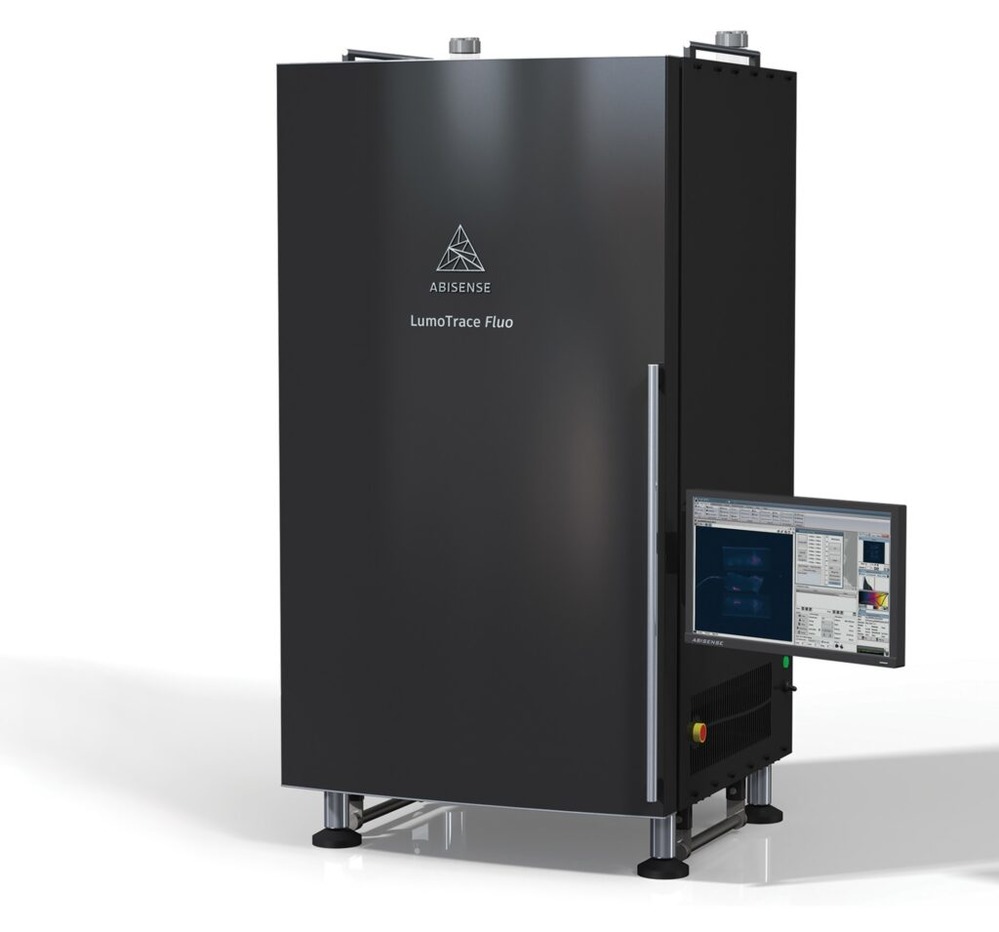Catalog
Search
44 products
View:
- Selected: 0Areas of use
- Selected: 0Item names
- Selected: 0Manufacturer
- Selected: 0Made in
- Selected: 1Additional
View:
44 products
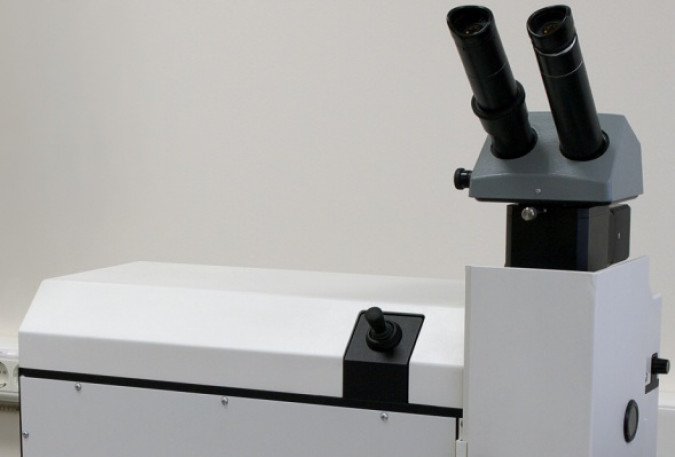
Two-pulse laser source of excitation of atomic emission spectra
The laser source is designed to excite atomic emission spectra when performing qualitative spectral analysis of hard rocks - metals, minerals, glasses and others.
The source is based on a two-pulse YAG: Nd laser with electro-optic Q-switching operating at the main wavelength of 1064 nm. The duration of each pulse is no more than 10 ns, and the delay between them is adjustable from 0 to 60 microseconds.
The possibility of the laser beam to focus on an area of 300 to 1000 microns makes it possible to conduct microanalysis of inclusions, perform two-dimensional scanning of the surface or locally analyze samples with virtually no damage to the surface. A significant advantage of the laser source is the expressiveness and lack of special sample preparation for a wide range of conductive and non-conductive materials.
Visual observation and pointing of the beam at the sample is carried out using a stereoscopic microscope integrated into the system, as well as a high-resolution digital video camera with image transmission to a computer.
Moving the instrument table with a fixed sample is possible both manually for adjustment, and with the help of stepper motors in two coordinates during analysis, which provides surface scanning and spectrum recording with reference to the video image. The installation can be used in conjunction with any spectral devices – "Grand", "Aspect", "Express", "Hummingbird-2", STE-1, DFS-458, MFS-8, PGS-2 and others. The laser source is designed to excite atomic emission spectra when performing high-quality spectral analysis of hard rocks – metals, minerals, glasses and others.
VMK OPTOELEKTRONIKA
Novosibirsk
Produced in: Novosibirsk
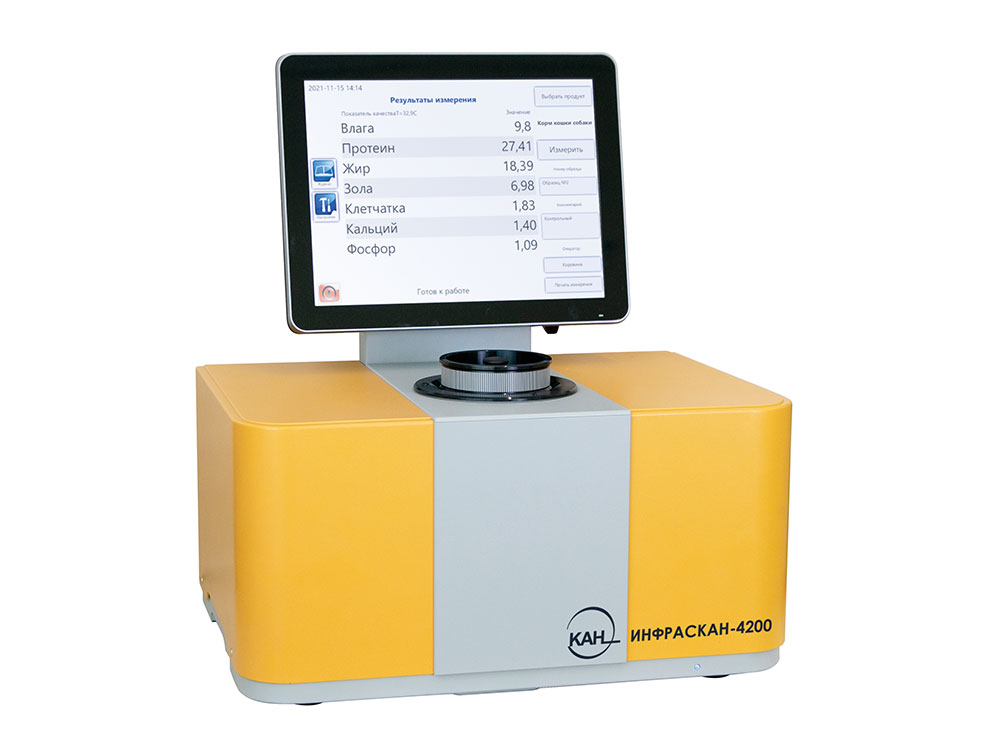
Infrared analyzer INFRASKAN 4200
1 supp.
The INFRASKAN 4200 analyzer has been tested at the D.I. Mendeleev VNIIM, entered into the unified State Register of measuring instruments under No. 83050-21. All manufactured devices undergo primary verification and have the appropriate certificate.
Analyzes a wide range of quality indicators (protein, moisture, quantity and quality of gluten (IDC), fat/oil content, water absorption capacity, acid number, peroxide number, m.d. phosphorizing substances, etc.)
Is calibrated to assess moisture and protein in whole grains (wheat, barley).
The cuvette compartment for the analysis of bulk, liquid and pasty products allows to analyse liquid vegetable oils without the use of additional devices.
The built-in whiteness module allows to determine the whiteness of the product simultaneously with other quality indicators (moisture, protein, amount of gluten). A wide spectral range (400-2500nm) provides measurement of the zonal reflection coefficient to determine the whiteness of flour in accordance with the GOST 26361-2013 methodology.
It is possible to calculate the amino acid composition of feed components.
To organize the work of analyzers in the ECANET network, the INFRASCAN-4200 analyzer can be used as a server for storing and transmitting data.
The remote access mode allows to remotely update existing calibrations, install additional calibration models and develop new calibration models for new products, as well as make adjustments to technical settings if necessary.
GK EKAN
Saint Petersburg
Produced in: Saint Petersburg
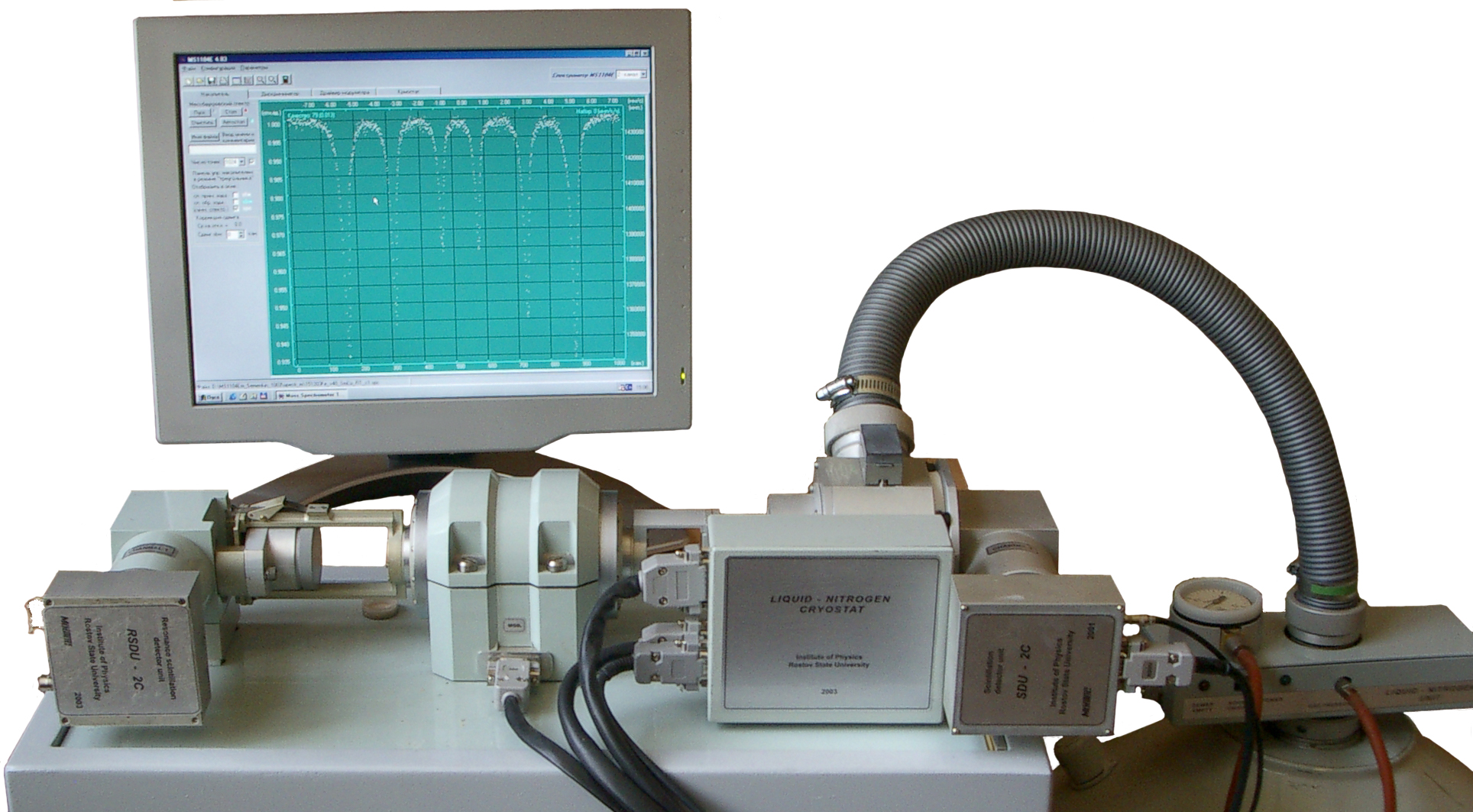
Express Mössbauer spectrometer MS1104Em
The MS-1104E spectrometer is characterized by high performance and accuracy of Mössbauer measurements achieved through the use of “compressed” geometry, as well as the use of highly efficient and selective resonant scintillation detection units that improve the energy resolution of resonance absorption lines by up to 30%. The technique of software and hardware stabilization of the spectrometric path developed and used in the spectrometer allows for long-term Mossbauer measurements without manual adjustment. The method of modulation in the specified speed intervals can significantly increase the sensitivity and expressiveness of measurements and reduce the time to determine the magnitude of the effects of resonant absorption by tens of times in the study of temperature phase transitions with a low concentration of resonant elements.
The electronic components of the spectrometer are developed on the basis of a modern element base using programmable logic matrices and microprocessors. Adjustable spectrometric paths and high-voltage power supplies of the PMU are integrated into detection units, modulator driver modules and multi-channel storage are made in the ISA standard and are located in the processor unit of the computer. Setting and monitoring of all parameters of the spectrometer and processing of the measured spectra is carried out from the operating windows of the control and processing programs.
Since 2000, more than ten spectrometers of this type have been supplied to leading scientific organizations in Russia and neighboring countries. One of the few industrial applications of Mössbauer spectroscopy should be noted - the development and supply to the Volgodonsk NPP of certified MS-1104Em methods and spectrometer for monitoring corrosion processes in the heat exchange circuits of the VVER-1000 reactor.
Department of Analytical Instrumentation SFU
Ростов-на-Дону
Produced in: Rostov-on-Don
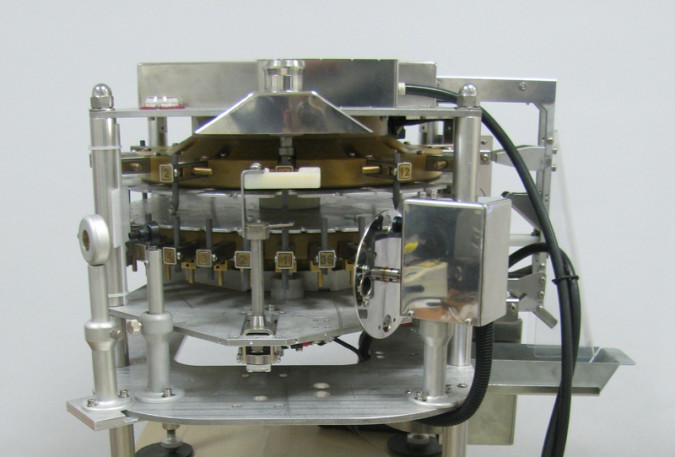
Remote-controlled atomizer
A remote-controlled atomizer of powder samples with automatic change of revolver-type samples with arc excitation of the spectrum. It consists of an automatic tripod "Carousel" for arc spectral analysis and a spectroanalytic generator "Ball Lightning"– 40A fully compatible with the expert software system "ATOM" and the MAES analyzer.
VMK OPTOELEKTRONIKA
Novosibirsk
Produced in: Novosibirsk
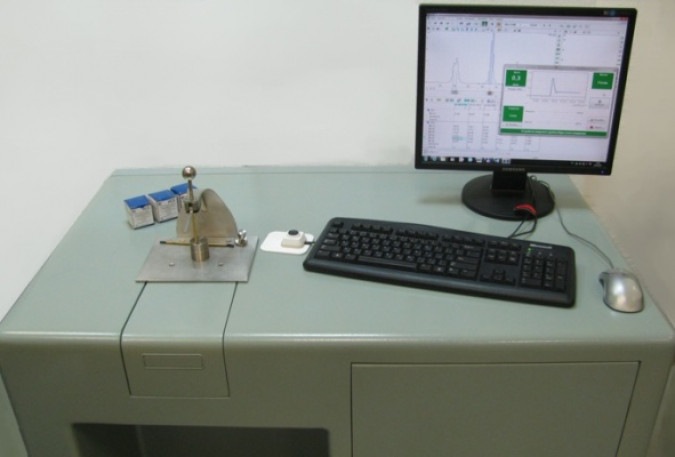
Steam generator of analytical samples of metal samples "Aspect"
During operation, the steam generator of metal samples "Aspect" provides control of all devices of the atomic emission spectral analysis complex - the MAES analyzer, the Ball Lightning generator, the inclusion of external devices;
A spark unipolar discharge is excited between a tungsten counterelectrode and the surface of the test samples - ingots of precious metals or other metal samples;
The intensity of erosion of the sample surface is regulated by changing the repetition frequency and power of spark pulses generated by a computer-controlled semiconductor spark generator;
The stability and quality of the frisking is monitored using a built-in spectrometer via optical fiber;
An adjustable flow of high-purity argon passes through the spark discharge zone in a sealed discharge chamber, picks up sample particles obtained by spark erosion of the surface and transfers them in the form of an aerosol to the area of the mixer/sprayer of the inductively coupled plasma torch of the optical emission spectrometer.;
The flow of high-purity argon is supplied, controlled and regulated by a microprocessor-controlled mass flow controller in the range from 0.5 to 3 l/min. Feed stability 0.01 l/min.
VMK OPTOELEKTRONIKA
Novosibirsk
Produced in: Novosibirsk
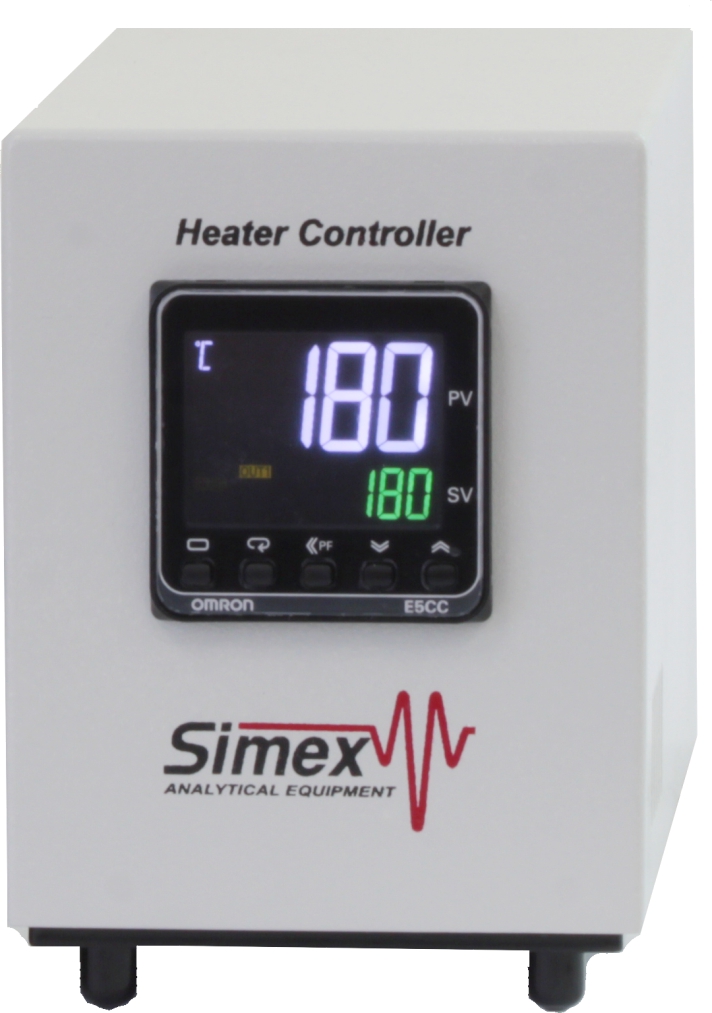
Diamond thermal cell NPVO with temperature controller
The sample heating system is designed to expand the capabilities of standard set-top boxes NPVO-ZDO and NPVO-A. It consists of a heated replaceable frame with a diamond prism and a temperature controller unit.
For most solid samples in the heated state, it is possible to obtain a much more pronounced NPV spectrum than in the cold state. This makes it possible to increase the sensitivity of the method several times.
The properties of some substances and compounds change dramatically with an increase in temperature, chemical interaction processes between components, their decomposition, oxidation in air, etc. may occur. If changes in the chemical composition of a substance occur during heating, a set of spectra corresponding to the kinetics of the process can be obtained with the help of an NPVO prefix with a diamond thermocell and a temperature controller, which is essential expands the possibilities of the method in research.
Technical characteristics of the NPVO set-top box with a thermocell and a controller
Transmission in the operating range of the spectrum, % of the input signal at least 10
The recommended number of scans when registering spectra is 25
Spectrum registration time at 25 scans (resolution 4 cm-1), sec 30
The depth of penetration of radiation into the sample, microns 5 – 15
Minimum dimensions of the solid sample, mm 0.5 × 0.5
Minimum volume of the liquid under study, ml 1
Minimum dimensions of the fiber sample: cross-section diameter/length, mm 0.3/1
The material of the crystal substrate is DIAMOND
The diameter of the free zone of the crystal, mm not less than 2 x 3
The diameter of the focus spot, mm 1.5
Maximum temperature With 220o
Adjustment accuracy, With 1o
Time to reach the maximum temperature, min 10
Overall dimensions, mm 130×200×90
Weight, kg 1,2
SIMEKS
Novosibirsk
Produced in: Novosibirsk

PRIZ - a reflection prefix with the lower position of the sample and visualization of the object under study on the monitor
The main advantage of the PRIZ prefix is the possibility of obtaining well–defined spectra of micro-objects after giving them the shape of a thin layer on mirror-polished metal plates (in the mode of the so-called double passage, when radiation twice penetrates through the layer of matter, reflecting from the mirror-substrate). The presence of a visual control system with a built-in video camera significantly increases the information content when setting up and the reliability of the results obtained. With the help of the prefix, it is also possible to register the reflection spectra of bulk samples and solid objects of arbitrary geometry in native form, including pharmaceuticals in the form of tablets, powders and granules, polymer fragments, LCP, films deposited on the surface.
Technical specifications
Transmission in the operating range of the spectrum, % of the input signal at least 40
The recommended number of scans when registering spectra is 25
Spectrum registration time at 25 scans (resolution 4 cm-1), sec 30
Minimum initial dimensions of a solid sample, mm 0.2 × 0.2
The maximum area of the solid sample, mm 20X20X10
Variable focus range, mm 10
The diameter of the focus spot, mm 3
The angle of incidence of radiation (central beam) on the sample in the ZDO 45o mode
Micro lens magnification / total magnification of the 4X visual channel
Field of view of the optical system, mm 2 X 2.5
The resolution of the digital video camera is 640x480
Overall dimensions, mm 140×105×160
Weight, kg 1.16
SIMEKS
Novosibirsk
Produced in: Novosibirsk
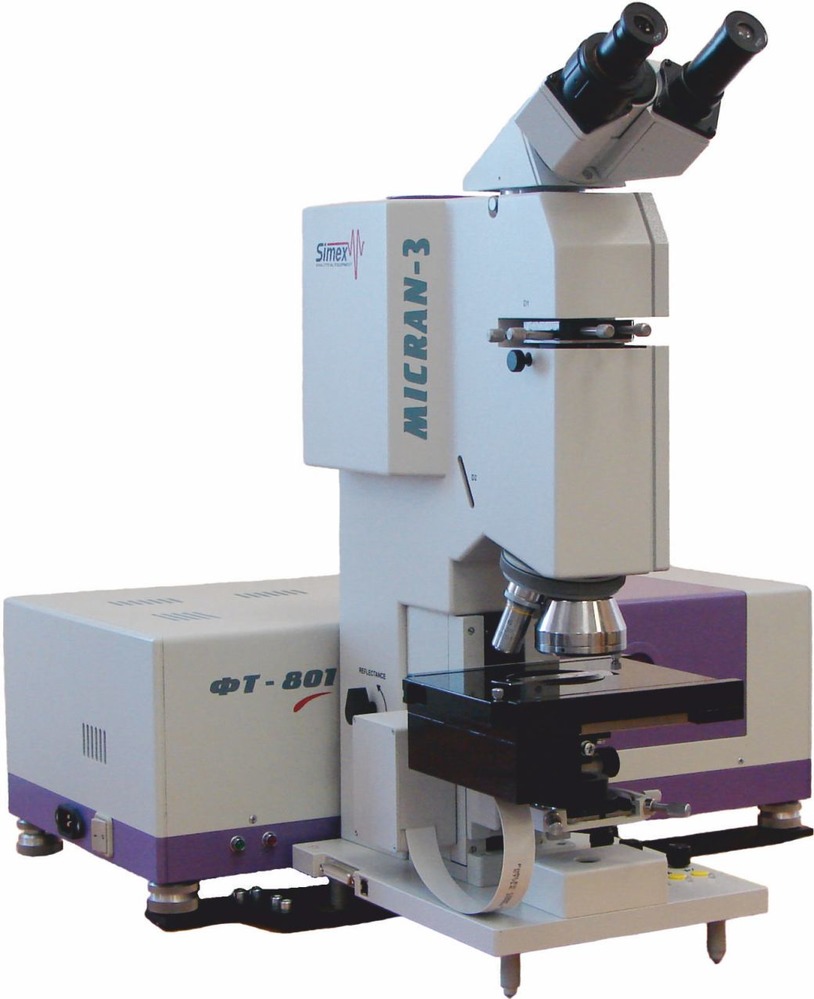
IR microscope "MIKRAN-3"
A higher–level device with extreme sensitivity and an additional set of functions that allow you to expand the possibilities for conducting spectral studies:
· revolver mechanism with 4 interchangeable lenses - mirror IR 15X, NPVO, lens 4X, lens 10X;
· registration of spectra in the modes of specular and diffuse reflection, transmission and NIP;
· increased sensitivity, which allows recording the spectra of micro-objects with sizes from 5 microns;
· built-in control panel with advanced functions;
· automated mapping system;
· the rectangular slit diaphragm is made of special glass – after the fragment is selected, the rest of the field of view is also available to the user, which greatly simplifies photometry of extended surfaces with local inhomogeneities;
· specialized software for controlling the microscope and processing the results.
Liquid nitrogen is required to work with an IR microscope.
SIMEKS
Novosibirsk
Produced in: Novosibirsk
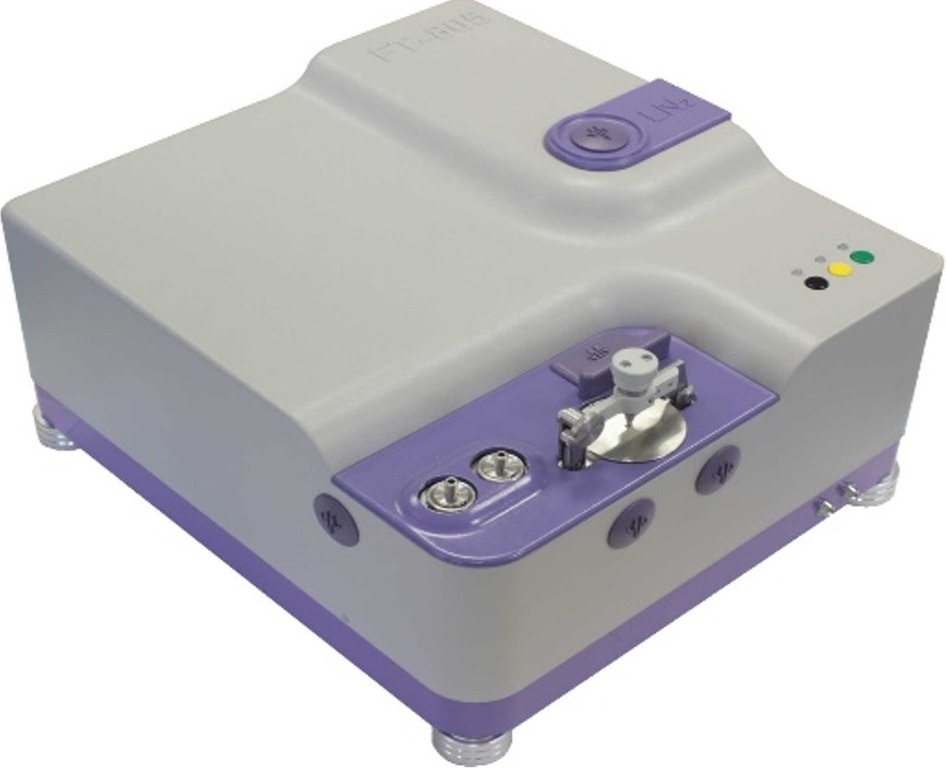
FT-805 IR Fourier spectrometer
A small-sized IR Fourier spectrometer with integrated set-top boxes and two detectors, including a highly sensitive cooled MST. Operating modes: transmission and reflection, NIP, measurements using fiber-optic probes (possible versions with one or two pairs of built-in connectors). It is possible to connect an IR microscope, a telescope to register the spectra of external radiation. The spectrometer can be used as a portable one, and is used, among other things, for express monitoring of technological processes, quality control of liquids in tanks and pipelines, during in-line analyses of biological objects, remote gas analysis.
The installation is designed to create high-quality images on various materials and provides the production of rubber cliche seals and stamps with a resolution of at least 1800 dpi.
Description
It was created on the basis of the innovative Shtrik platform, which is based on a unique control system, the hardware and software of which are entirely developed by specialists of our company.
The installation is designed to create high-quality images on materials such as rubber, metal, plastic and provides the production of cliche seals and stamps with a resolution of at least 1800 dpi.
The fiber laser used in the installation in combination with a system of galvanometric scanners ensures high quality engraving in static mode, does not require water cooling and special maintenance.
When assembling the system, only tested and certified parts are used, which guarantees an especially long service life without additional investments.
Features:
A two-coordinate high-precision positioning system for samples, with the help of which the object table is moved along the X, Y axes. As a result of the positioning system and sequential engraving of image fragments, it is possible to process with high accuracy workpieces with dimensions up to 200 × 300 mm in automatic mode according to the processing program set by the operator;
The algorithm of automatic layer-by-layer engraving using a high-precision mechanism for moving the scanning head along the Z-coordinate allows you to form highly detailed 3D images up to 5 mm deep in metal workpieces (steel, brass, aluminum, titanium, etc.);
A long process of layer-by-layer engraving of deep 3D images (possibly tens of hours) is provided without operator involvement thanks to an automatic algorithm;
The installation is equipped with a built-in system for removing combustion products from the laser radiation exposure zone, as a result of which, the absence of odors and protection of the scanning lens from the products of production is ensured, which is especially important when engraving rubber and plastics;
The installation body completely covers the processing and propagation zones of laser radiation, and the engraving is performed according to the program set by the operator in automatic mode with the installation covers closed. This design of the installation allows it to be attributed to laser devices of hazard class 1.
SIMEKS
Novosibirsk
Produced in: Novosibirsk
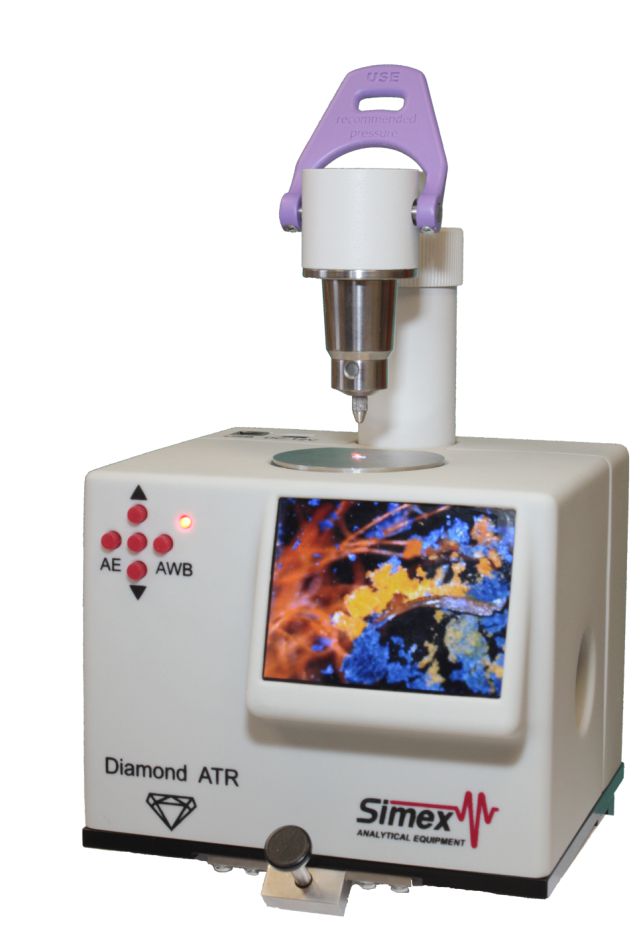
Universal set-top box of NPVO and ZDO with a diamond element and a built-in mini-monitor
It is designed for measurement by the method of disturbed total internal reflection with simultaneous visualization of a micro-object on an integrated and external monitor, as well as by the method of mirror-diffuse reflection with an angle of incidence of 45o at the upper location of the sample.
The prefix in the mode of a single NIP is used to register absorption spectra:
liquids of any degree of viscosity (solutions, suspensions, oils, etc.), including those with high chemical activity;
solid objects of arbitrary shape, including samples with very high hardness (any polymers, fragments of paint coatings, etc.);
powdery substances, including powders with very high hardness (drugs, pharmaceuticals, explosives, inorganic compounds);
samples in the form of thin tapes;
samples in the form of fibers.
The maximum hardness and chemical resistance of the diamond significantly expand the possibilities of the method; there is no need for periodic replacement of the crystal.
The set-top box allows you to register spectra without time–consuming sample preparation, and the presence of a visual inspection system of the studied surface with a high-quality video camera and a built-in high-definition mini-monitor increases efficiency when working with small samples - fragments of thin fibers, microparticles, etc. The built-in monitor has the functions of digital 10X zoom, inverting, etc. The image can be simultaneously displayed on the computer screen (using a USB interface) and then saved as a file.
The removable flange provides a quick and convenient sample change and cleaning of the crystal surface. The design with a diamond element protruding above the base plane of the NPVO allows you to study samples with sufficiently large overall dimensions.
The high quality and repeatability of the results is achieved due to the absence of the influence of the thickness of the substance layer on the shape of the spectrum and the intensity of the absorption bands.
The sample retains its original physicochemical properties and, if necessary, can be further investigated by other methods.
The universal attachment clamp is equipped with a precision lever mechanism for quickly lowering the tip and a micrometer screw that allows you to pre–set the optimal degree of pressure - this ensures quick sample change and repeatability of the results during measurements. For convenience when working with liquid and paste-like samples, as well as in the ZDO mode, it is possible to rotate the clamping console by 180o. The console is equipped with two replaceable tips – with a spherical working part and with a flat hinged head. The high hardness of the diamond allows the use of large clamping forces, which is the determining factor for obtaining high-quality spectra. A replacement table is used to register the specular and diffuse reflection spectra. The sample is located on the subject plane of the investigated surface downwards. The method is used to determine the spectral characteristics of optical parts, thin tapes on the surface, crystals, and other large solid objects of arbitrary shape and size.
SIMEKS
Novosibirsk
Produced in: Novosibirsk
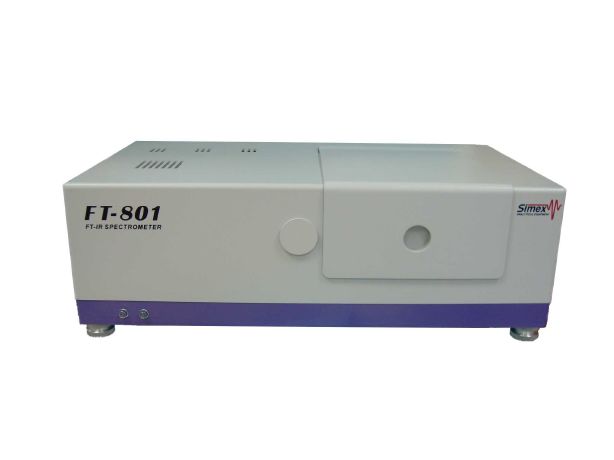
FT-801 IR Fourier spectrometer
It is designed for recording absorption spectra of solid, liquid and gaseous substances in the near and middle IR region (including drugs, lacquers and paints, petroleum products, explosives, pharmacological preparations, polymer films and fibers) with their subsequent identification, as well as for qualitative and quantitative analysis of mixtures containing several components.
SIMEKS
Novosibirsk
Produced in: Novosibirsk
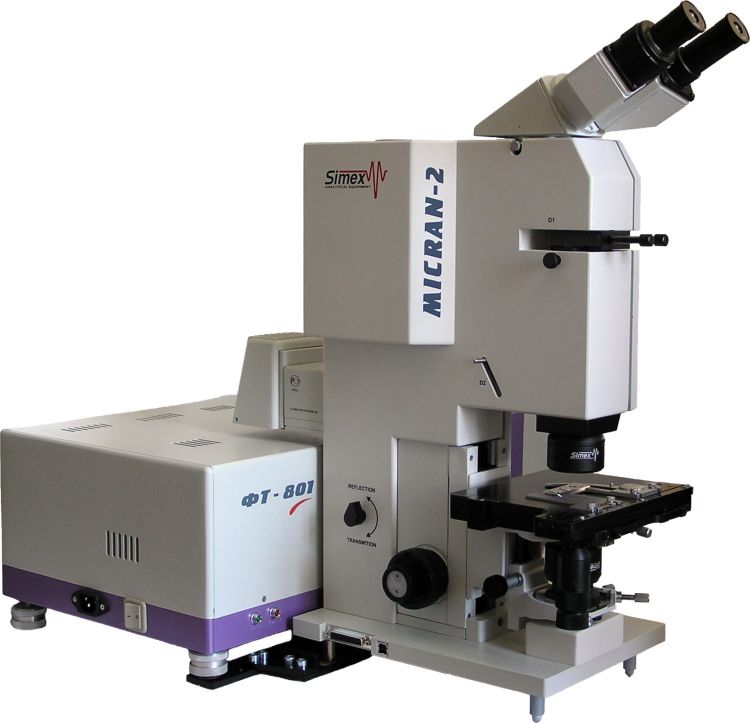
Spectral measuring complex: automated IR Fourier spectrometer "FT-801" with IR microscope "MIKRAN-2"
2 supp.
from
100 500 ₽
The wide-range IR microscope of the MICRAN series, connected to the FT-801 and Infralum FT-801 Fourier spectrometers, is designed to study samples from 10 microns in size, including heterogeneous in composition. When working on an IR microscope, the operator has the opportunity to observe the object under study with a magnification of over 200X both using binoculars and on a monitor using a digital video camera, during photometry, select a local area of arbitrary shape with the help of diaphragms, and also “scan” the surface of the sample, observing the spectrum obtained in real time.
SIMEKS
Novosibirsk
Produced in: Novosibirsk
